-
Posts
5,308 -
Joined
-
Last visited
-
Days Won
5
Content Type
Profiles
Forums
Blogs
Gallery
Events
Store
Posts posted by leigh kitchen
-
-
Or unless you read a particular copy of "Crown Imperial" about 1984 - from an article by Andrew Chaney, a sketch of the FID shoulder title, locally made, in brass.
Also worn on the slouch hat I would think?
The original was on display at the INt Corps museum at Ashford, Kent - I don't know where the museum is nowadays.
Field Intelligence deal with int. on the enemies organistaion, capabilities, tactics & intentions & with the geography of the battlefield & with counter intelligence to protect own personnel, information & equipmentd.
Intelligence units were viewed as war raised rather than permanent requirements prior to WWII (when the Int. Corps was established in 1940), but the Anglo-Boer War showed the British that there was a need for such a corps.
The FID was established to provide operational intelligence, Natal being at the forefront of such activity, units such as the Natal Corps of Guides (comprised of local white farmers & black guides) provided intelligence for the FID, which grouped guides, interpretors, scouts & native scouts into fixed grades & introduced field security & intelligence gathering procedures such as censorship, POW interrogation, field sketching, Ballon recce reports, carrier pigeons,etc.
The British had sent over a small number of British officers including a Major Rimmington who formed the Rimmington Scouts who were often referred to as the "Intelligence Corps".
Although the informal Int. Corps units were'nt authorised insignia, various scout units produced their own slouch hat & shoulder insignia.
Medals to personnel of these units were inscribed "FID".


 0
0 -
nah, it's Brit - a Naval Coronet.........
0 -
The red square with the 3 white seaxes is the Essex County Division.
0 -
 "GREETINGS & SALUTATIONS!" Chris, I removed the red from the background and lightened the image of the Grenadier Guard epaulette for you here!
"GREETINGS & SALUTATIONS!" Chris, I removed the red from the background and lightened the image of the Grenadier Guard epaulette for you here!  Sarge Booker of Tujunga, California
Sarge Booker of Tujunga, California 
The shoulder strap bears the cypher of King George VI in the centre of the design - so the buttons required bear that version of the cypher, slightly less ornate & more squared off than the King George V version.
King George VI - 1936 - 52, but I would imagine that there was quite an overlap with the insignia change at both ends of the reign, though having said that, King Edward VIII insignia was produced for the GG, & he was only around for what - was it 18 months or less?
0 -
Cheers Chris
Nice family history and interesting photos of a bygone age. If my memory serves me correctly I have seen police photos with similar badges on uniforms and I think they may be for a first aid qualifications.
Possibly the St John's qualification badge, circular, about 2" diametere & of white metal, but I thought these were worn on the right upper sleeve.
0 -
"Probably taken at the same time as the photos above. I wonder if those barrack like rooms in the background are the classrooms. The old building in the left hand side background of the bottom photo looks fairly impressive. Bit of a long shot but does anyone recognise it?"
Looks like Eynsham Hall, Oxfordshire, it's now an activities centre, conference centre, hotel - something like that.
Just done a search on the web - there are quite a few sites on it - you can even take the missus there for a romantic weekend & some tuition in medievel axe throwing.
In all seriousness, you have the chance to follow in dads footsteps but without the parades, exams & cross country runs - nice surroundings.
I've just thought - Eynsham Hall fetured in the Roger Graf series "Police" in about 1980 - 81.
An appalling series from a police point of view (a big well done to Sir Peter Imbert for that one) - Graef managed to find police officers who were a little different & less capable than the norm, but anyway - one of the episodes features police training at Eynsham Hall.
0 -
Blackened yellow metal issued to 1st Bn GG for a tour of North Armagh in 1976, according to my ex-Grenadier informant - it was produced blackened, not unit painted.
I don't know if this badge is still in use.
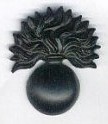
 0
0 -
This embroidered badge is the NCO's arm badge, issued in lieu of the beret badge proper because of shortages during the 1st Bn's 1973 tour of "Derry.
0 -
This embroidered badge was issued to 1st Bn GG in 1973 - I saw it in wear in the Creggan in @Derry that year & my ex-Grenadier mate tells me that they were a short lived badge issued for a 4 month Emergency Tour.

 0
0 -
The gold coloured anodised aluminium issue, K&K volume 2 page 23 refers to this in text.
An ex-Grenadier of Queen's Company 1st Bn in the 70's did'nt know these existed, having been issued a yellow metal one.

 0
0 -
The WWII light bronze plastic economy version, K&K 2206 refers.
21,072 were produced after 2/11/43, all by "F & G" (Militaria Magazine issue 12).
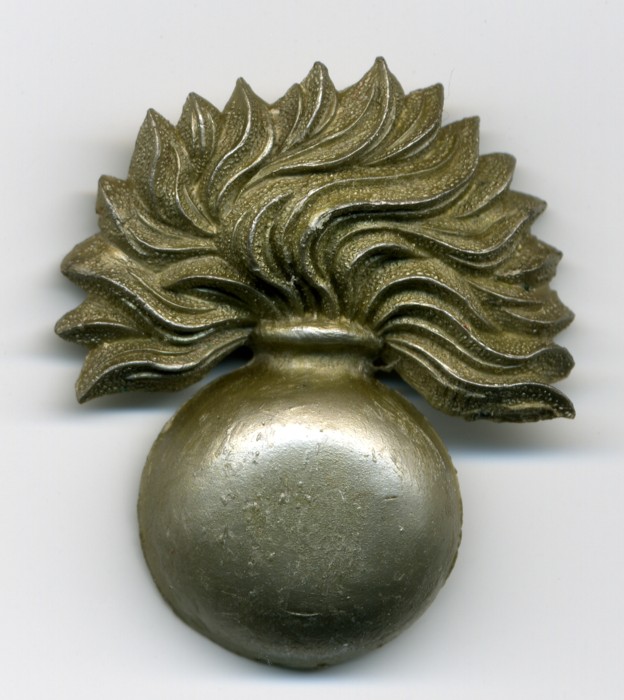
 0
0 -
This is a 15 point flame - or perhaps a 14

 0
0 -
I can't remember when the crowned garter & cypher design took over from the grenade shoulder strap device, yep, the GS buttons are wrong but there should be plenty of KGV or KGVI Grenadier's buttons around - I don't know which king's buttons are right for this particular.
0 -
This badge has 16 points or perhaps 17 to the flame

 0
0 -
These badges have 16 points to the flames
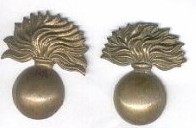
 0
0 -
These badges have 17 point flames, there are slight manufacturers variations between them.

 0
0 -
The Grenadier Guards wear the "flamed grenade" as a cap badge, ranks below full sergeant ("gold sergeant") and other than musicians (the guards term for what the army generally call bandsmen) wear the grenade with no device on the ball.
The grenade has been worn since 1896 when it was introduced for wear on the forage cap and continues unchanged in basic design although the materials used have varied.
Properly made of a yellow metal whch Kipling & King refer to as being gilding metal rather than brass, a WWI economy issue in brass would have been worn 1916 - c1919, but who can tell the metals apart?
K&K 891 refers to these gilding metal badges, as does Gaylor, both show the 17 pointed flame version & make no mention of the other less full flamed versions.
Both show smaller flamed badges but only of the types with devices on the ball, such as the full sergeants & musicians etc.
Some collectors feel that the smaller flamed 14, 15, 16 pointed flame badges are Canadian Grenadier Guards badge, but photographs & postcards show these & the 17 point flame badges worn by both British & Canadian.
During WWII a plastic economy version was issied, these were to be worn alongside the gilding metal badge, units were not to standardize on one version or the other so some men within a unit could wear brass, others plastic.
Often referred to as "being of "bakelite", these badges were actually of plastic.
Later an gold coloured anodised aluminium version was issued, and a cloth embroidered version of a noticably different design to the norm.
A blackened yellow metal version of the badge was also issued.
This photo shows a badge with 18 points to the flames:
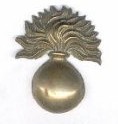
 0
0 -
I've never been able to identify these, they are of standard British type manufacture.............
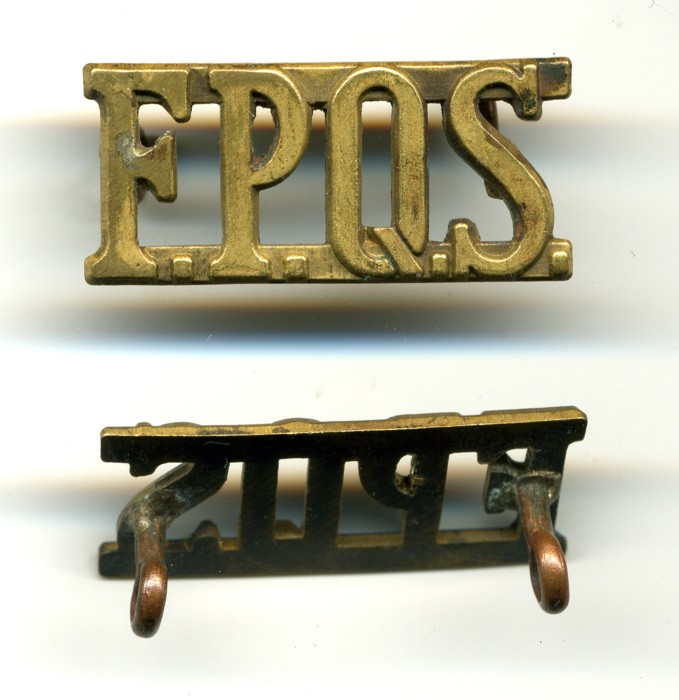
 0
0 -
I've had this for over 20 years, & I think that I found it in a book about that time & worked out that it is Siamese, but not exactly what it is.
It has 3 x copper loop fittings on the reverse, it appears to be of British manufacture.
It's about 7 cm tall.
Does anybody know exactly what it is please?

 0
0 -
Just putting these up because I like them & I've never seen any similar - a Swedish friend found them somewhere a few years ago & sent them over to me.
The usual buttonhole fitting on the backs, the smaller one has a manufacturers mark which I can't make out at the moment - a London manfacturer.
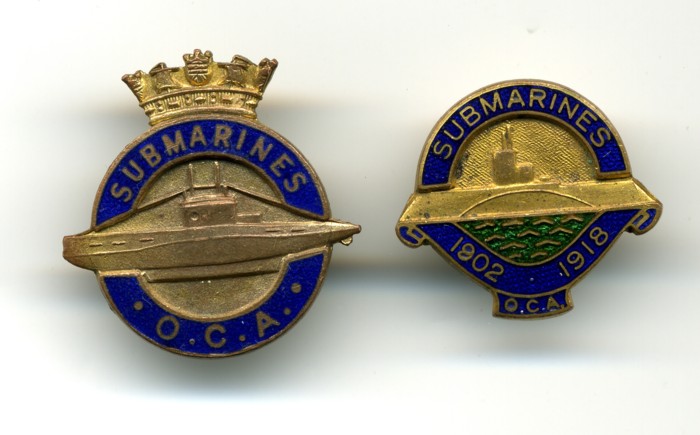
 0
0 -
Here's the reverse of the 5th Army medal.
This site has a couple of "Naples" medals for sale, one has "Allied Armies" on the obverse along with a large tree, & is fitted with what appears to be a Monte Casino Cross ribbon, the other is a 5th Army one which has a simlilar obverse to your 8th Army one, other than the wording, l.e. it lacks the boats in the harbour that my 5th Army one has. It has a similar ribbon to the first but looks as if it's black & red rather than blue & red stripes.
http://www.treasurebunker.com/acatalog/Bri...ign_medals.html
Notice how my 5th Army one refers to "Allied Armies" on the reverse whereas your 8th Army one refers to "British Army"?
I'd always thought that these were just produced in identical format with just the 5th or 8th varying, but these things seem a whole field in themselves.

 0
0 -
It could be that the open tunics were on a trial issue prior to adoption nation wide.
I was wondering if the group shot with the variety of tunics etc is actually a training college shot, at two of the men (rear left & rear second from right) appear to be City of London Polices
Certainly by 1980 Essex were wearing the crested pattern helmet as opposed to the rose or "t*t" type with enamelled or rather plastic central design to the plate, I think with chrome fittings & possibly a black plastic band, possibly blackend brass? I have photos somewhere but they're not really relavant to this thread.
I think the terms for the two different styles of helmetare "Guardian" & "Home Office".
0 -
Are you sure about the dates of service? The photo of your dad & the radio car shows him in the open neck tunic, which I think came was introduced in 1960, another photo shows a group, some in high neck, some open neck.
Although worn on the shoulder straps nowadays & in some cases on a breast badge instead, the numbers are still referred to as "collar numbers" harking back to the old tunics.
0 -
A repost of a thread in US Orders & Medals - I am interested in finding what information I can on this man please - he was in the USMC & fought during WWII & in Korea & Vietnam, he held the Silver Star, Bronze Star, South Vietnamese Cross of Honour (?), was wounded 11 times & was apparently captured by the enemy in Vietnam a number of times but always escaped before actual incarceration.
When he was 86 years old (about 2001) he was awarded a citation by the Oklahoma State Legislature in recognition of his military service, & received a letter from the State Governor.
I've seen the citation & letter, a photo, a couple of newspaper clippings & a few other bits & pieces to him today & would like to know more about him - a quick search on Google etc was negative.
Any info on this man would be gratefully received, ta.
0




WWI Medals To South African Wonded & KIA Brothers.
in Great Britain: Orders, Gallantry, Campaign Medals
Posted
My first South African WWI medals arrived a couple of days ago, "just" a VM & a BWM - a broken pair & a broken trio but I like them.
Sgt LB Tedder was a member much wounded member of 2 SAI (commissioned in December 1918), 2/Lt OS Tedder, his brother, was a member of 8 Lincolnshires & was KIA 27/4/17.
Sgt LB Tedders Vctory Medal & attestation papers: